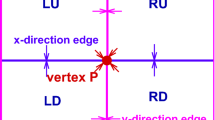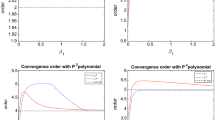Abstract
In this paper, we propose a discontinuous Galerkin scheme with arbitrary order of accuracy in space and time for the magnetohydrodynamic equations. It is based on the Arbitrary order using DERivatives (ADER) methodology: the high order time approximation is obtained by a Taylor expansion in time. In this expansion all the time derivatives are replaced by space derivatives via the Cauchy-Kovalevskaya procedure. We propose an efficient algorithm of the Cauchy-Kovalevskaya procedure in the case of the three-dimensional magneto-hydrodynamic (MHD) equations. Parallel to the time derivatives of the conservative variables the time derivatives of the fluxes are calculated. This enables the analytic time integration of the volume integral as well as that of the surface integral of the fluxes through the grid cell interfaces which occur in the discrete equations. At the cell interfaces the fluxes and all their derivatives may jump. Following the finite volume ADER approach the break up of all these jumps into the different waves are taken into account to get proper values of the fluxes at the grid cell interfaces. The approach under considerations is directly based on the expansion of the flux in time in which the leading order term may be any numerical flux calculation for the MHD-equation. Numerical convergence results for these equations up to 7th order of accuracy in space and time are shown.
Similar content being viewed by others
References
Dumbser M., Munz C.-D. (2005). Building blocks for arbitrary high order discontinuous Galerkin schemes. J. Sci. Comput. ISSN: 0885-7474 (Paper) 1573-7691 (Online), DOI: 10.1007/s10915-005-9025-0, Issue: Online First.
Toro E., Titarev V. (2003). Solution of the generalized Riemann problem for advection-reaction equations. Proc. Roy. Soc. A: Mathematical, Physical and Engineering Sciences. 458 (2018): 271–281
Titarev V.A., Toro E.F. (2005). ADER schemes for three-dimensional nonlinear hyperbolic systems. J. Comput. Phys. 204: 715–736
Becker J. (2000). Entwicklung eines effizineten Verfahrens zur Lösung hyperbolischer Differentialgleichungen. http://www.freidok.uni-freiburg.de/volltexte/123 (October 2000)
Dumbser M. (2005). Arbitrary High Order Schemes for the Solution of Hyperbolic Conservation Laws in Complex Domains. Shaker Verlag, Aachen
Cockburn B., Shu C.W. (1989). TVB Runge–Kutta local projection discontinuous Galerkin finite element method for conservation laws II: general framework. Math. Comput. 52: 411–435
Cockburn B., Shu C.W. (1998). The Runge–Kutta discontinuous Galerkin method for conservation laws V: multidimensional systems. J. Computat. Phys. 141: 199–224
Stroud A.H. (1971). Approximate Calculation of Multiple Integrals. Prentice-Hall Inc., Englewood Cliffs, NJ
Toro E.F., Millington R.C., and Nejad L. A. M. (2001). Towards very high order Godunov schemes, in: Godunov Methods. Theory and Applications, Kluwer/Plenum Academic Publishers, pp. 905–938.
Titarev V.A., Toro E.F. (2002). ADER: arbitrary high order Godunov approach. J. Sci. Comput. 17(1–4): 609–618
Dyson R. W. (2001). Technique for very high order nonlinear simulation and validation. Tech. Rep. TM-2001-210985, NASA.
Balsara D.S. (1998). Linearized formulation of the Riemann problem for adiabatic and isothermal magnetohydrodynamics. Astrophys. J. Suppl. Ser. 116: 119–131
Cargo P., Gallice G. (1997). Roe matrices for ideal MHD and systematic construction of Roe matrices for systems of conservation laws. J. Comput. Phys. 136(2): 446–466
Roe P.L., Balsara D.S. (1996). Notes on the eigensystem of magnetohydrodynamics. IMA J. Appl. Math. 56(1): 57–67
Balsara D.S. (2001). Total variation diminishing scheme for relativistic magnetohydrodynamics. Ap. J. Supp. 132: 1
Ryu D., Jones T.W. (1995). Numerical magnetohydrodynamics in astrophysics: algorithm and tests for one-dimensional flow. Astrophys J. 442: 228–258
Dai W., Woodward P. R. (1994). Extension of the piecewise parabolic method to multidimensional ideal magnetohydrodynamics. J. Comput. Phys. 115(2): 485–514
Balsara D. S., A sub-cell based indicator for troubled zones in RKDG schemes and a novel class of hybrid RKDG+HWENO schemes. ArXiv Physics e-prints arXiv:physics/0411160, Provided by the Smithsonian/NASA Astrophysics Data
Qiu J., Shu C.W. (2003). Hermite WENO schemes and their application as limiters for Runge–Kutta discontinuous Galerkin method: one-dimensional case. J. Comput. Phys. 193: 115–135
Author information
Authors and Affiliations
Corresponding author
Rights and permissions
About this article
Cite this article
Taube, A., Dumbser, M., Balsara, D.S. et al. Arbitrary High-Order Discontinuous Galerkin Schemes for the Magnetohydrodynamic Equations. J Sci Comput 30, 441–464 (2007). https://doi.org/10.1007/s10915-006-9101-0
Received:
Accepted:
Published:
Issue Date:
DOI: https://doi.org/10.1007/s10915-006-9101-0




